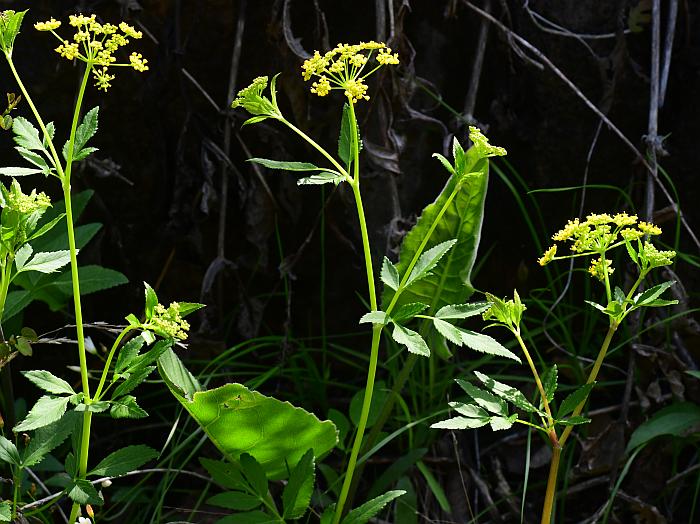Thaspium barbinode (Michx.) Nutt.
Hairy-Joint Meadow-Parsnip

Native
CC = 7
CW = 3
MOC = 6
© SRTurner
Thaspium barbinode (Michx.) Nutt.Hairy-Joint Meadow-Parsnip | |
 |
Native CC = 7 CW = 3 MOC = 6 |
© SRTurner |
|
Family - Apiaceae Habit - Perennial forb. Stems - Erect, to 70 cm, sometimes with a band of short, white hairs at the base of at least the uppermost leaf sheaths, sometimes also sparsely and minutely hairy toward the tip.
Leaves - Basal and alternate. Basal leaves with the blades 6-25 cm long, 1 or 2 times compound, the leaflets 1-12 cm long, lanceolate to ovate, tapered to rounded at the base, sometimes with 1 or 2 lobes toward the base, the margins otherwise finely to coarsely toothed, short-hairy, not whitened, the upper surfaces glabrous to sparsely pubescent, the lower surfaces glabrous or with pubescence restricted to primary veins. Stem leaves similar to the basal leaves, 1-2 times ternate, gradually reduced in size and degree of dissection toward the stem tip.
Inflorescences - Terminal and axillary, compound umbels, short-to long-stalked. Involucre usually absent. Rays 6-12, 1-4 cm long, nearly equal in length, glabrous or slightly roughened. Involucel of linear bractlets, the bractlets shorter than the flower stalks. Flowers 9-19 or more in each umbellet, all with short stalks (1-5 mm long).
Florets - Florets 9-19 (to numerous) in each umbellet, all with short stalks (1-4 mm long). Sepals absent or more commonly minute, triangular to obovate scales. Petals obovate, narrowed or tapered abruptly to a short, slender tip, bright yellow when fresh. Ovaries glabrous.
Fruits - Schizocarps, 5-6 mm long at maturity, ovate, flattened dorsally, glabrous, the mericarps with 5 ribs, these with prominent, somewhat corky, light yellow to straw-colored wings, scabrellous between and sometimes on several wings, with prominent reddish brown oil tubes filling the spaces between the ribs. Flowering - April - June. Habitat - Mesic limestone and sandstone wooded bluffs and ledges, near springs, river bluffs. Origin - Native to the U.S. Lookalikes - T. chapmanii, T. trifoliatum, Zizia aurea. Other info. - In the past, this species in Missouri has not been clearly differentiated from T. chapmanii, but recent studies by Dr. Aaron Floden (Missouri Botanical Garden) have pointed to a number of subtle differences. The most striking is the color of the florets, which is bright yellow in this species but pale yellow in T. chapmanii. The color difference tends to fade over time, with the result that this character is lost in herbarium specimens. Other differentiating attributes include: earlier flowering, shorter stature, less abaxial leaflet pubescence, and less leaf division in this species vs. T. chapmanii. Because of the difficulty in assigning historical herbarium specimens, the distribution of this species is somewhat uncertain; however, it appears to be less widely distributed in Missouri than T. chapmanii. Beyond Missouri the species is confined to the eastern half of the continental U.S. Photographs taken at St. Joe State Park, St. Francois County, MO, 4-28-2020 (SRTurner). |